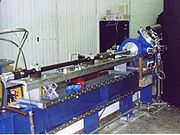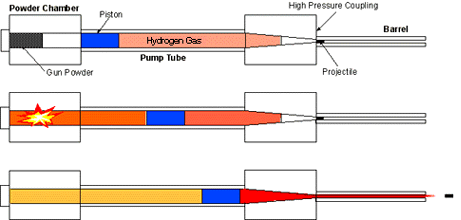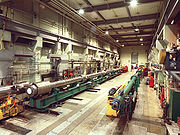
Light gas gun
Encyclopedia

Ballistic impact
Ballistic impact is a high velocity impact by small mass simulation analogous to runway debris or small arms fire. The simulation uses a light gas gun or other ballistic launcher. Ballistic impact loads are necessary to study material response....
(hypervelocity
Hypervelocity
The term hypervelocity usually refers to a very high velocity, approximately over 3,000 meters per second . In particular, it refers to velocities so high that the strength of materials upon impact is very small compared to inertial stresses. Thus, even metals behave like fluids under hypervelocity...
research), such as the formation of impact crater
Impact crater
In the broadest sense, the term impact crater can be applied to any depression, natural or manmade, resulting from the high velocity impact of a projectile with a larger body...
s by meteorite
Meteorite
A meteorite is a natural object originating in outer space that survives impact with the Earth's surface. Meteorites can be big or small. Most meteorites derive from small astronomical objects called meteoroids, but they are also sometimes produced by impacts of asteroids...
s or the erosion of materials by micrometeoroid
Micrometeoroid
A micrometeoroid is a tiny meteoroid; a small particle of rock in space, usually weighing less than a gram. A micrometeor or micrometeorite is such a particle that enters the Earth's atmosphere or falls to Earth.-Scientific interest:...
s. Some basic materials research relies on projectile impact to create high pressure: such systems are capable of forcing liquid hydrogen
Liquid hydrogen
Liquid hydrogen is the liquid state of the element hydrogen. Hydrogen is found naturally in the molecular H2 form.To exist as a liquid, H2 must be pressurized above and cooled below hydrogen's Critical point. However, for hydrogen to be in a full liquid state without boiling off, it needs to be...
into a metallic state
Metallic hydrogen
Metallic hydrogen is a state of hydrogen which results when it is sufficiently compressed and undergoes a phase transition; it is an example of degenerate matter. Solid metallic hydrogen is predicted to consist of a crystal lattice of hydrogen nuclei , with a spacing which is significantly smaller...
.
Operation

Piston
A piston is a component of reciprocating engines, reciprocating pumps, gas compressors and pneumatic cylinders, among other similar mechanisms. It is the moving component that is contained by a cylinder and is made gas-tight by piston rings. In an engine, its purpose is to transfer force from...
airgun. A large-diameter piston is used to force a gaseous working fluid through a smaller-diameter barrel containing the projectile to be accelerated. This reduction in diameter acts as a lever, increasing the speed while decreasing the force. In an airgun, the large piston is powered by a spring or compressed air, and the working fluid is atmospheric air. In a light-gas gun, the piston is powered by a chemical reaction (usually gunpowder), and the working fluid is a lighter gas, such as helium
Helium
Helium is the chemical element with atomic number 2 and an atomic weight of 4.002602, which is represented by the symbol He. It is a colorless, odorless, tasteless, non-toxic, inert, monatomic gas that heads the noble gas group in the periodic table...
or hydrogen
Hydrogen
Hydrogen is the chemical element with atomic number 1. It is represented by the symbol H. With an average atomic weight of , hydrogen is the lightest and most abundant chemical element, constituting roughly 75% of the Universe's chemical elemental mass. Stars in the main sequence are mainly...
(though helium is much safer to work with, hydrogen offers the best performance [as explained below], and causes less launch-tube erosion). One addition that a light-gas gun adds to the airgun is a rupture disk, which is a carefully calibrated disk (usually metal) designed to act as a valve. When the pressure builds up to the desired level behind the disk, the disk tears open, allowing the high-pressure, light gas to pass into the barrel. This ensures that the maximum amount of energy is available when the projectile begins moving.
One particular light-gas gun used by NASA
NASA
The National Aeronautics and Space Administration is the agency of the United States government that is responsible for the nation's civilian space program and for aeronautics and aerospace research...
uses a modified 40 mm cannon for power. The cannon uses gunpowder to propel a plastic (usually HDPE) piston down the cannon barrel, which is filled with high-pressure hydrogen gas. At the end of the cannon barrel is a conical section, leading down to the 5 mm barrel that fires the projectile. In this conical section is a stainless steel disk, approximately 2 mm thick, with an "x" pattern scored into the surface in the middle. When the hydrogen develops sufficient pressure to burst the scored section of the disk, the hydrogen flows through the hole and accelerates the projectile to a velocity of 6 km/s in a distance of about a meter.
NASA also operates light-gas guns with launch tube sizes ranging from 0.17 inch (0.4318 cm) to 1.5 in (3.8 cm) at Ames Research Center. These guns have been used in support of various missions beginning with Apollo reentry studies in the 1960s and most recently for high-speed thermal imaging. Velocities ranging from 1 km/s up to 7 km/s can be achieved. The largest of these involves a 6.25 inches (15.9 cm) diameter piston weighing more than 46 pounds (20.9 kg) to compress the hydrogen.

Arnold Air Force Base
Arnold Air Force Base is a United States Air Force base located in Coffee and Franklin counties, Tennessee, adjacent to the city of Tullahoma. It is named for General Henry "Hap" Arnold, the father of the U.S. Air Force....
Range-G is the largest light-gas gun facility in the United States. Range-G utilizes interchangeable launch tubes ranging from a bore diameter of 3.3 inches (8.4 cm) to 8 inches (20.3 cm) with a 14 inches (35.6 cm) piston weighing up to 2300 pounds (1,043.3 kg). Projectile velocities can reach up to 4.5 km/s for the 8 inches (20.3 cm) configuration and up to 7 km/s for the 3.3 inches (8.4 cm) launcher configuration. The primary use of the range facilities at Arnold Air Force Base is the measurement of released kinetic energy upon projectile impact.
Design physics
The limiting factor on the speed of an airgun, firearmFirearm
A firearm is a weapon that launches one, or many, projectile at high velocity through confined burning of a propellant. This subsonic burning process is technically known as deflagration, as opposed to supersonic combustion known as a detonation. In older firearms, the propellant was typically...
, or light-gas gun is the speed of sound
Speed of sound
The speed of sound is the distance travelled during a unit of time by a sound wave propagating through an elastic medium. In dry air at , the speed of sound is . This is , or about one kilometer in three seconds or approximately one mile in five seconds....
in the working fluid—the air, burning gunpowder, or a light gas. This is essentially because the projectile is accelerated by the pressure difference between its ends, and such a pressure wave cannot propagate any faster than the speed of sound in the medium. The speed of sound in helium is about three times that in air, and in hydrogen 3.8 times that in air. The speed of sound also increases with the temperature of the fluid (but is independent of the pressure), so the heat formed by the compression of the working fluid serves to increase the maximum possible speed. Spring piston airguns increase the temperature of the air in the chamber by adiabatic heating; this raises the local speed of sound enough to overcome frictional and other efficiency losses and propel the projectile at more than the speed of sound in the ambient conditions. Light-gas guns have been built that are capable of propelling projectiles at speeds of up to 11 km/s, over 11 times the velocity of which small-bore firearms are capable.
Hybrid electrothermal light-gas gun
The hybrid electrothermal light-gas gun works on similar principles of the standard light-gas gun, but adds an electric arc to heat the light gas to a higher temperature and pressure than the piston alone. The arc is applied in the chamber containing the light gas, raising the temperature and pressure to the point where the gas both breaks the bursting disk and ignites the propellant behind the piston, which is perforated to allow ignition. The resulting combination of electrical heating and piston compression provide higher pressures and temperatures, resulting in more power and a higher potential speed than a standard light-gas gun.Impact profile
When the projectile fired by a gas gun impacts its target, the pressure applied depends upon the mass of the projectile. Obviously, a dense projectile will apply more pressure overall than a light one, but researchers have recently begun to vary their projectiles' density as a function of length. Since the projectiles travel at a known velocity, changes in density as a function of length have a predictable relationship to the impact pressure applied as a function of time. With materials in a wide range of densities (from tungstenTungsten
Tungsten , also known as wolfram , is a chemical element with the chemical symbol W and atomic number 74.A hard, rare metal under standard conditions when uncombined, tungsten is found naturally on Earth only in chemical compounds. It was identified as a new element in 1781, and first isolated as...
powder to glass microsphere
Glass microsphere
Glass microspheres are microscopic spheres of glass manufactured for a wide variety of uses in research, medicine, consumer goods and various industries. Glass microspheres are usually between 1 to 1000 micrometers in diameter, although the sizes can range from 100 nanometers to 5 millimeters in...
s) applied in thin layers, carefully made projectiles can be used in constant-pressure experiments, or even controlled compression–expansion–compression sequences.
See also
- Ram acceleratorRam acceleratorA ram accelerator has the same function as a gun; i.e., it is a device for accelerating projectiles; however, it is entirely different in that jet-engine-like propulsion cycles utilizing ramjet and/or scramjet combustion processes are used to accelerate a projectile to extremely high speeds...
, a high-velocity gun that uses different principles to achieve similar projectile velocities. - Shock tubeShock tubeFor the pyrotechnic initiator, see Shock tube detonatorThe shock tube is an instrument used to replicate and direct blast waves at a sensor or a model in order to simulate actual explosions and their effects, usually on a smaller scale...
, a tool used to demonstrate the properties of very high speed gases. - Combustion light-gas gun, a high-velocity gun that uses combusted gas as propellant.
- Super High Altitude Research ProjectSuper High Altitude Research ProjectThe Super High Altitude Research Project was a U.S. government project conducting research into the firing of high-velocity projectiles high into the atmosphere using a two stage light gas gun, with the ultimate goal of propelling satellites into Earth orbit...
- Spacegun

